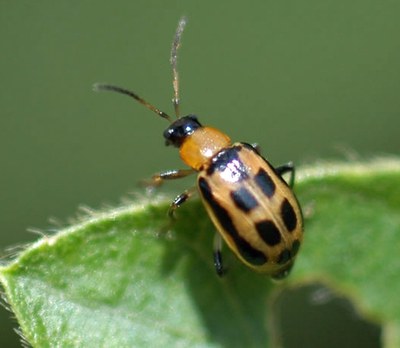Common Arthropod Pests of Soybeans in North Dakota (E2005, Dec. 2020)
Foliage Feeding Caterpillars
Green Cloverworm
Caterpillar (larva, Figure 1): Mature larva about 1¼ inches long. Pale green, with one long narrow white stripe on each side, three pairs of fleshy prolegs at the center part of the body and one pair of prolegs at the rear end. Moves in a looping behavior. Chew on leaves and pods.
Adult (Figure 2): Wingspan of 1 inch. Dark brown moth with spots. When moth rests, wings form a triangle. Migrates into North Dakota each spring.
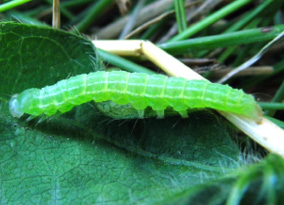
- Figure 1. Larva - green cloverworm (J. Gavloski, Manitoba Agriculture, Food and Rural Initiatives)
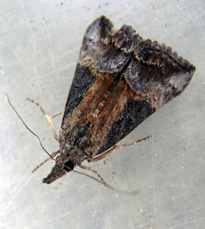
- Figure 2. Green cloverworm moth (J. Gavloski, Manitoba Agriculture, Food and Rural Initiatives)
Painted Lady Butterfly
Thistle Caterpillar (larva, Figure 3): Mature larva about 1½ inches long. Brown to black with yellow striping along each side of the body and covered with branched spiny hairs (giving a prickly appearance). Webbed nest in curled leaves where they feed on foliage. Black pellets (frass) inside web.
Adult (Figure 4): Wing span of 2½ to 3½ inches. Forewings red-orange and brown with black and white spots. Hindwings orange-brown with four black “eye spots” along edge. Feeds on flower nectar and aphid honeydew. Migrates into North Dakota each spring.
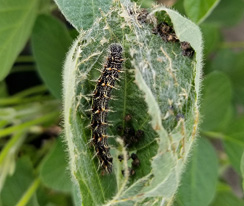
- Figure 3. Thistle caterpillar in webbed nest (V. Calles-Torrez, NDSU)
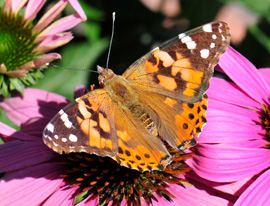
- Figure 4. Painted lady butterfly (P. Beauzay, NDSU)
Soybean Aphid
Nymph (Figure 5): Similar to adult, but smaller and wingless.
Adult (Figure 6): Small, about 1/16 inch long, light yellowish-green pear-shaped body, black cornicles (look like tailpipes on posterior end), either winged or wingless.
Both nymphs and adults feed on plant juices.
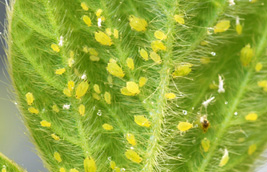
- Figure 5. Soybean aphid nymphs and adults on underside of leaf (P. Beauzay, NDSU)
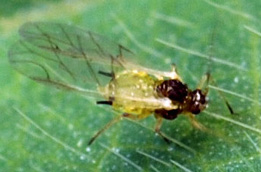
- Figure 6. Adult - soybean aphid (P. Beauzay, NDSU)
Spider Mite
Immature: Similar to adult, but smaller with six to eight legs.
Adult (Figure 7): Small, less than 0.02 inch (magnification is needed to see them in detail), green, yellow or orange body, two dark spots on the abdomen for two-spotted spider mite, eight legs. Located on the undersides of leaves. Produce spiderlike webbing (Figure 8) and stippling injury on leaves (Figure 9).
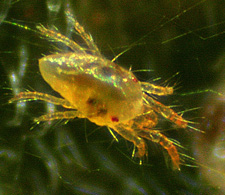
- Figure 7. Two-spotted spider mite (D. Cappaert, Michigan State University, Bugwood.org)
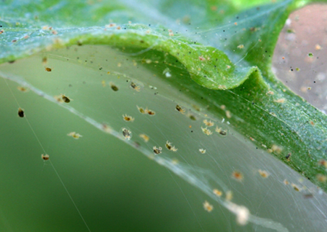
- Figure 8. Webbing from two-spotted spider mites (D. Cappaert, Michigan State University, Bugwood.org)
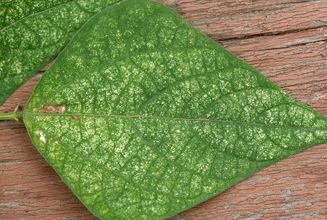
- Figure 9. Stippling injury from two-spotted spider mites (W. Cranshaw, Colorado State University, Bugwood.org)
Armyworm
Larva (Figure 10): Light tan to dark greenish-brown caterpillar with three longitudinal stripes (pale orange, white, brownish or/and black) on smooth and almost hairless body, about 1½ to 2 inches long when mature. Defoliate leaves/pods, usually in moist, shady areas with lodged plants.
Adult (Figure 11): Light brown moth with a conspicuous white spot about the size of a pinhead on each front wing, wingspan of 1½ inches.
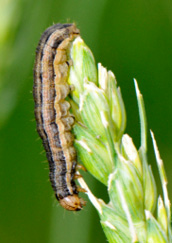
- Figure 10. Larva - armyworm (P. Beauzay, NDSU)
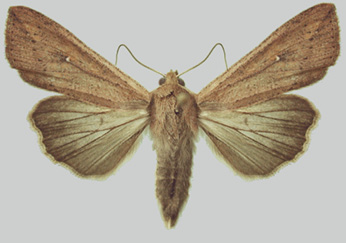
- Figure 11. Adult - armyworm (G. Fauske, NDSU)
Bean Leaf Beetle
Larva: White body with a brown head, about ¼ inch long when mature. Found in soil, feeds on roots, root hairs and nodules.
Adult (Figures 14 and 15): About ¼ inch long, oval-shaped, greenish-yellow to reddish-brown beetle, with four black spots on wings (spots also can be absent) and black margin near wing edges. Beetle always has a black triangular mark in middle and behind prothorax. Adults feed on foliage causing small, round holes between leaflet veins and on pods (Figure 16).
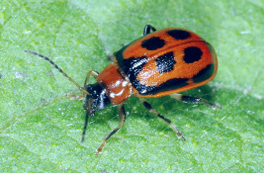
- Figure 15. Adult - red bean leaf beetle (J. Kalisch, Nebraska State University)
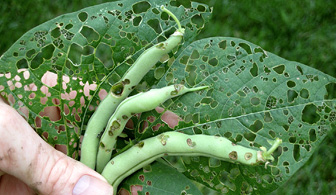
- Figure 16. Bean leaf beetle defoliation and pod damage (J. Kalisch, Nebraska State University)
Cutworm
Larva (Figure 12): Black to pale gray body with markings (spots or stripes), 1½ inches long when mature. Cut young plants below or above ground.
Adult (Figure 13): Dark gray, brown or dull yellow or tan moths with dark wing markings, robust body, wingspan length of 1¼ to 1½ inches.
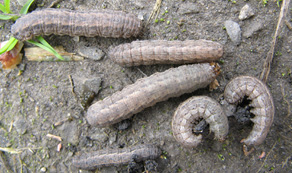
- Figure 12. Larva - dingy cutworm larva (J. Gavloski, Manitoba Agriculture, Food and Rural Initiatives)
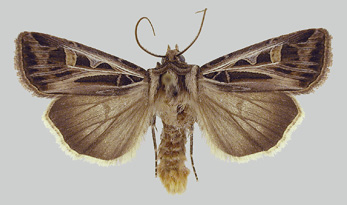
- Figure 13. Adult - dingy cutworm (G. Fauske, NDSU)
Potato Leafhopper
Nymph (Figure 17): Similar to adult, but smaller, wingless and greenish yellow.
Adult (Figure 18): Less than 1/8 inch long, narrow, wedge-shaped, pale green body. Wings are transparent green and folded over back at rest. Nymphs and adults jump or walk rapidly sideways when disturbed. Migrates into North Dakota each spring.
Both nymphs and adults feed on plant juices.
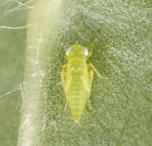
- Figure 17. Nymph - potato leafhopper (S. Brown, University of Georgia, Bugwood.org)
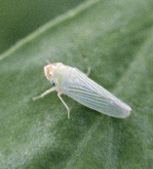
- Figure 18. Adult - potato leafhopper (S. Brown, University of Georgia, Bugwood.org)
Published with supported from the North Dakota Soybean Council and the USDA National Institute of Food and Agriculture, Hatch Project Accession No. 1018411 and the Crop Protection and Pest Management Program [grant no. 2017-70006-27144].



